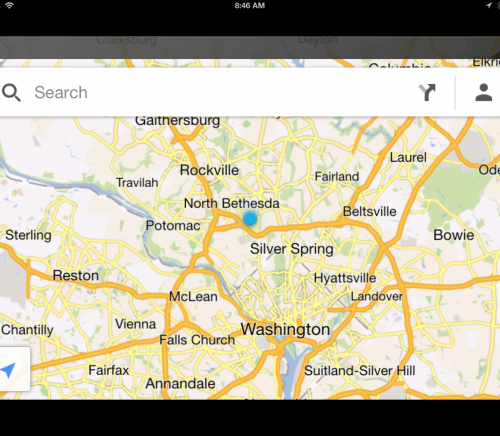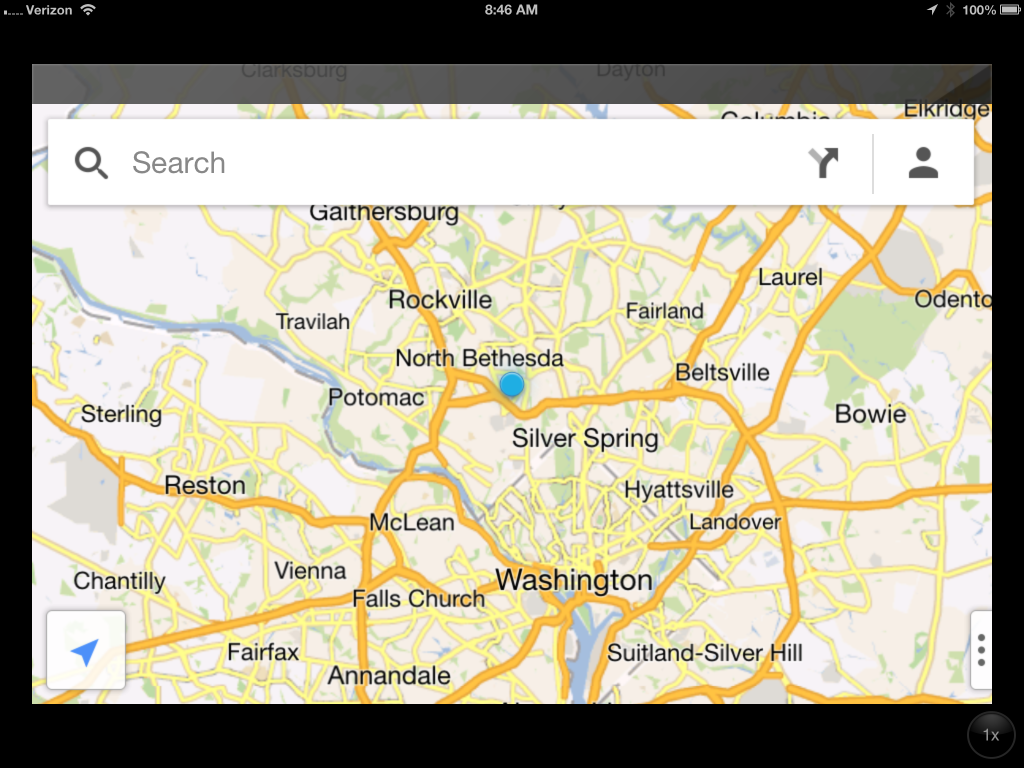Google’s failure to understand that a tablet is something other than a really big phone is becoming one of the great mysteries of the technology world. The Android tablet business has been crippled by a lack of dedicated tablet apps, a situation that Google has done almost nothing to correct. Now Google has confirmed my worst fears with the release of the long-awaited Google maps for iOS.
Google maps for the iPhone is lovely. It’s better than the old Google-based iOS Maps app, adding vector maps and turn-by-turn directions. And it draws on slick search abilities and deep geographic data knowledge, the lack of which can make using Apple’s own Maps app an adventure. And Google maps integrates transit information (a feature sadly not available in the Washington, DC, area.)
But the iPad is a very different story. For whatever reason, Google did not bother to come up with a separate iPad-optimized version. Like any other iPhone app, Maps will run on the iPad, but like any other iPhone app, it looks ghastly. The picture above shows Google Maps on a third-generation iPad in 2X mode (the alternative would be to display an iPhone-sized image in the middle of the screen.) . Scrolling and zooming is not as smooth as on the iPhone, and notice the enormous amount of screen area that is wasted by by simply scaling up the various on-screen controls.
This is all rather hard to understand, since Google should have had no trouble developing an iPad version in parallel with the phone edition. Much smaller developers do this all the time. I can only hope that Google will realize that the iPad is something more than a larger iPhone and correct the error quickly.


“For whatever reason, Google did not bother to come up with a separate iPad-optimized version.”
Good catch, Steve. I’d like to give Google the benefit of the doubt and assume that an iPad-optimized version of their map program is on its way. But based on Google’s history, it’s awfully hard to make that assumption. They just don’t seem to get tablets.
Its coming.
http://www.latimes.com/business/technology/la-fi-tn-google-maps-iphone-ipad-20121212,0,3884968.story
“Daniel Graf, the director of Google Maps for Mobile, told The Times that an iPad version of the app is on its way. He said Google wants to place Google Maps on all platforms, but the Mountain View-based company decided to focus first on the iPhone.”
I’m sure it will show up eventually, but I remain surprised that Google didn’t do it right away. The amount of effort required to tweak the app so that it was at least acceptable on iPad was not that great and Google isn’t a little two-person shop.
Did you forgot the demo they gave in June ? They gave direct demo on iPad during event.
I agree with your sentiment. I am not someone to dump on a company like Google or its Android OS because I prefer Apple products. Many people I respect use the Android OS for whatever reason and get by just fine.
What the lack of native Google Maps for iPad and Android tablets reinforces is a point made often by techpinion’s writers- end users are not Google’s customers, advertisers and data miners are.
While advertisers et al. may be Google’s customers, crappy apps will cause Google to fail to deliver to those customers the product they seek – end user eyeballs.
Makes a whole lotta sense!
It seems I read on this website, one of the writers mentioned that Google has only recently realized that Android apps need to be rewritten for tablets. Perhaps this is just a carryover of that mindset.
I think it’s a bit harsh to jump to this conclusion.
The lack of special tablet apps on Android is because of the enormous hardware fragmentation.
Android runs on hundreds of different screen sizes and resolutions from 240×320 3″ screens all the way up to 2560×1600 10″ screens and developers are supposed to write one app that works on all of them.
It just doesn’t make sense to try to make a clear distinction like on iOS.
As iPhone is obviously the more mobile and guarranteed to be GPS enabled device it makes perfect sense to prioritise it over iPad.
Devs should have at least 2 versions …. One for 3-5″ phones and another for 7-10″ tablets
Phone apps have extremely low information density in order to have touch targets large enough for fingers, which totally sucks on tablets.
Google had spent tons of time on honeycomb and ICS, so why not ask devs to do the same ?
Because it’s just too much work.
Not every developer has the resources Google has.
I’m sorry, but this is nonsense. It’s quite easy to build a framework that lets you use whatever space is available. I’ve done this for several companies since long before there were standard toolkits on most platforms, much less cross-platform toolkits.
Beyond that, the Android phone market has at least as wide a disparity in screen resolutions, from the Motorola Droid (don’t get me started) to whatever Samsung’s Behemoth of the Week is. There’s a huge variation there; it’s quite trivial to throw tablets into the mix for this particular issue.
The same thing applies to iStuff, except that (to date) there are far less sets of resolutions to worry about.
Google’s Android team apparently didn’t find it so easy.
If you’re sure you know exactly how to fix this you should tell Google about it.
I’m confident they’ll reward you handsomely.
IDK, but I think they don’t have anything against tablets. One would have to actually give tablets some thought to have something against them. It appears Google has not given tablets much of any thought.
Joe
EggMaps HD was released today on the app store. It is a full-screen iPad-only app that provides Google Maps (including Google Transit). See http://www.eggmaps.com/ .
Hold on Google did have a Maps App for iPad from the day the iPad was released. Then with IOS6.0 apple removed it along with the YouTube App. To be fair to Google if Apple in their wisdom remove apps from our devices without our permission then it’s not Google problem. I reckon Google are holding off replacing the original app so Apple feel a bit of heat for being so rude in removing it in the first place. In saying this I do recognise the new version of the Google Map app does have turn-by-turn voice and a whole lot of other sexy enhancements that the first never did and I too can’t wait to see it on iPad. However, to say Google don’t get tablets is along way off the mark when they are the only other real tablet OS competitor out there with Microsoft way out the back lost in the wilderness with the Windows 8 offerings.
That’s not quite correct. The Maps app was Apple’s from the beginning, but it used Google map data. From the introduction of the iPad on, there were different versions for the iPhone and iPad. But Google and apple had a falling out over the terms on which Apple got to use the maps, specifically access to real-time navigation, and Apple decided to go with their own maps.
My complaint with Android for tablets is that Google seems to think of the tablet as a big phone and makes very little effort to optimize its software for the larger format. I am hardly alone in this belief.
Ok wasn’t aware of the Map App being Apples development. When we tried to use some of the sexy features in our own Apps i.e. the fancy page curl at the bottom of the original Map application we were told only a company as big as Google can get away with not following the Apple design guide and get away with it, so as a result we are a page curl free App development team. We also code for Android and the SDK and API for that framework supports any format from what I can see so I don’t think Google are thinking of the tablet as a big phone. The OS is clearly designed to run across everything from phones, tablets, home entertainment systems etc. Mind you it would have been a whole lot more interesting if the Chrome Book had also taken up this mobile OS however that merger hasn’t happened. I think we are seeing the Android OS getting the most penetration in the smart phone market, just have to look at the Samsung range, and still struggling to make a dent against the iPad with tablets, which gives the impression the only market they are in is the smart phone.
It’s a bit annoying. Google Maps is the best map app. Love the iPad, but, like everything else, it comes with annoyances. You can’t use Java on the iPad, for instance. (Why this is I’ve no idea.) Some widely used programs such as Adobe Flash are not compatible with the iPad. And that awful keyboard! The keyboard, above all else, is what Apple needs to change on the iPad.
You can’t run Java an an iPad because the Java Runtime would violate a number of iOS rules and could never get through the Apple approval process. and based on what we have seen recently with the deep-seated security problem of the Java Runtime on other platforms, this is a good thing.
When the iPad was being designed, Apple–Steve Jobs claimed credit for this one himself–decided that Flash would not be a good experience for users. Subsequent events have proven this judgment correct as Adobe itself has abandoned Flash as a mobile product and is no longer developing Flash for Android. Flash is too resource-hungry and too mouse-centric to work well on touch tablets.
Apple actually dropped Google maps last year (sept. 2012) to try and make their own mapping service. They purchased Tom Tom which just started switching to mapping. So long story short. They realized their maps suck and customers will be pissed. I’m sure they’ll go back to google if they haven’t already.
Apple did not purchase TomTom; they simply licensed the use of TomTom’s TeleAtlas maps. The problem with Apple’s Maps app is not really the maps, but the poor databases that accompany them.
However, there really is no going back here. Google has since introduced its own Maps app for the iPhone (still no iPad version.)
Very well presented. Every quote was awesome and thanks for sharing the content. Keep sharing and keep motivating others.
Very well presented. Every quote was awesome and thanks for sharing the content. Keep sharing and keep motivating others.